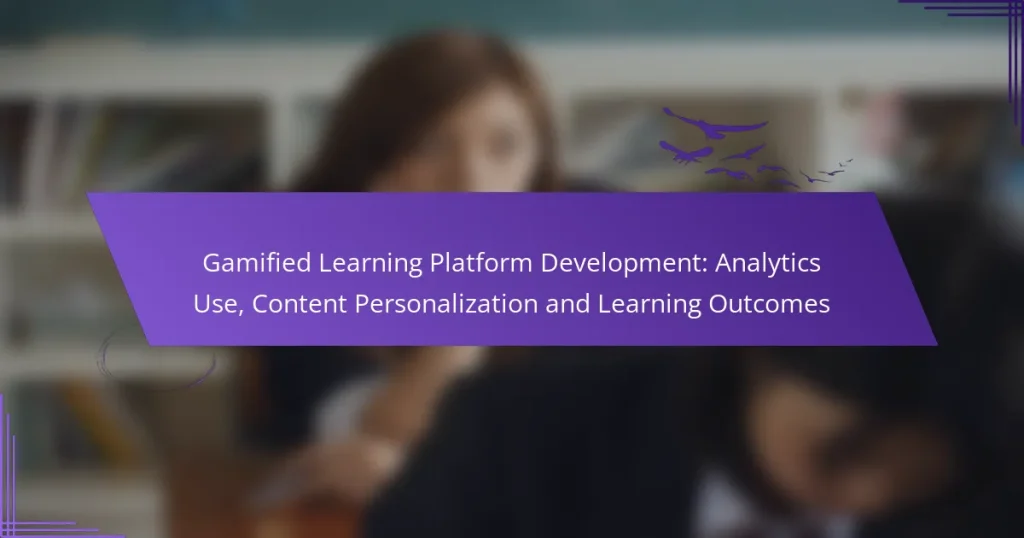Gamified learning platforms are revolutionizing education by integrating analytics to gain insights into user behavior and engagement. By leveraging this data, developers can personalize content, creating tailored educational experiences that enhance learning outcomes and foster deeper engagement among learners.

How can analytics improve gamified learning platforms?
Analytics can significantly enhance gamified learning platforms by providing insights into user behavior, engagement levels, and learning outcomes. By leveraging data, developers can tailor content to meet individual learner needs and improve overall effectiveness.
Data-driven insights for user engagement
Analytics tools can track user interactions within gamified learning environments, revealing patterns in engagement. For instance, metrics such as time spent on tasks, completion rates, and frequency of logins can indicate which elements captivate learners the most.
By analyzing these insights, developers can adjust game mechanics, such as rewards and challenges, to boost user motivation. A/B testing different features can help identify what resonates best with users, leading to higher retention rates.
Tracking learning progress and outcomes
Effective analytics allows for monitoring learners’ progress through various stages of the gamified experience. By collecting data on quiz scores, levels completed, and time taken to achieve goals, platforms can assess individual and group performance.
This information can inform educators about areas where learners struggle, enabling timely interventions. Setting benchmarks for progress can help in determining whether users are meeting expected learning outcomes, guiding future content development.
Identifying content effectiveness
Analytics can reveal which educational content is most effective in achieving desired learning outcomes. By evaluating user feedback and performance data, developers can determine which modules lead to higher engagement and knowledge retention.
Regularly reviewing content effectiveness allows for continuous improvement. For example, if a particular game level consistently results in low scores, it may need redesigning to enhance clarity or difficulty. Utilizing user surveys can also provide qualitative insights into content relevance and appeal.

What are the best practices for content personalization?
Effective content personalization enhances user engagement and learning outcomes by tailoring educational experiences to individual needs. Best practices include utilizing adaptive learning paths, analyzing user behavior, and providing dynamic content recommendations.
Adaptive learning paths
Adaptive learning paths adjust the educational journey based on a learner’s progress and performance. By assessing strengths and weaknesses, these paths can offer customized content that aligns with the learner’s pace and style, ensuring a more effective learning experience.
To implement adaptive learning paths, consider using algorithms that track user interactions and outcomes. This data can help create a flexible curriculum that evolves as the learner advances, avoiding frustration from overly challenging or simplistic material.
User behavior analysis
User behavior analysis involves collecting and interpreting data on how learners interact with the platform. This includes tracking metrics such as time spent on tasks, completion rates, and engagement levels, which can provide insights into user preferences and learning habits.
Utilize tools like heatmaps and click tracking to visualize user interactions. Regularly reviewing this data allows for timely adjustments to content and strategies, ensuring that the learning experience remains relevant and engaging.
Dynamic content recommendations
Dynamic content recommendations suggest personalized resources based on a learner’s previous interactions and preferences. By leveraging machine learning algorithms, platforms can curate content that resonates with individual users, enhancing their learning journey.
Consider implementing recommendation engines that analyze user data in real-time. This approach can lead to higher engagement rates and improved learning outcomes by presenting users with relevant articles, videos, or exercises tailored to their interests and needs.

How do gamified elements enhance learning outcomes?
Gamified elements significantly enhance learning outcomes by increasing engagement and motivation among learners. By incorporating game-like features, such as rewards and challenges, educational platforms can create a more interactive and enjoyable learning experience.
Increased motivation through rewards
Gamified learning platforms often use rewards to boost motivation, encouraging learners to complete tasks and achieve goals. These rewards can include points, badges, or unlockable content, which provide a sense of accomplishment. For example, a platform might offer a badge for completing a module, motivating users to progress through the material.
To maximize the effectiveness of rewards, it’s essential to ensure they are meaningful and aligned with learning objectives. Avoid overloading learners with too many rewards, as this can dilute their value. Instead, focus on a few significant achievements that resonate with users and encourage continued engagement.
Enhanced retention via interactive challenges
Interactive challenges are a key component of gamified learning, as they promote active participation and critical thinking. By presenting learners with quizzes, puzzles, or simulations, these challenges help reinforce knowledge and improve retention. For instance, a math learning app might include timed problem-solving games that require users to apply concepts in real-time.
To enhance retention, challenges should be appropriately difficult, providing just the right level of difficulty to keep learners engaged without causing frustration. Incorporating a variety of challenge types can cater to different learning styles, ensuring a broader appeal.
Real-time feedback mechanisms
Real-time feedback is crucial in gamified learning environments, as it allows learners to understand their progress and areas for improvement immediately. Instant feedback can be provided through scores, hints, or performance analytics, helping users adjust their strategies on the fly. For example, a language learning app might offer immediate corrections on pronunciation, enabling users to refine their skills quickly.
To implement effective feedback mechanisms, ensure that the feedback is constructive and specific. Avoid vague comments; instead, provide clear guidance on how to improve. Regularly updating feedback based on user performance can help maintain engagement and support continuous learning.

What frameworks support gamified learning development?
Several frameworks are essential for developing gamified learning platforms, focusing on instructional design and iterative improvements. The ADDIE model and Agile methodology are two prominent frameworks that help create engaging and effective learning experiences.
ADDIE model for instructional design
The ADDIE model is a systematic approach to instructional design that consists of five phases: Analysis, Design, Development, Implementation, and Evaluation. This framework helps educators and developers ensure that the learning objectives align with the needs of the learners and the content is effectively structured.
In the Analysis phase, identify the target audience and their learning needs. During the Design phase, outline the learning objectives and select appropriate gamification elements, such as points, badges, or leaderboards, to enhance engagement. The Development phase involves creating the actual content and integrating the gamified features.
Finally, in the Implementation phase, deploy the platform and monitor its usage, followed by the Evaluation phase, where feedback is gathered to assess the effectiveness of the learning experience. Regularly revisiting these phases can lead to continuous improvement.
Agile methodology for iterative improvements
The Agile methodology emphasizes flexibility and iterative progress, making it ideal for gamified learning development. This approach allows teams to adapt quickly to changes based on user feedback and evolving educational needs.
Using Agile, developers can break down the project into smaller, manageable tasks called sprints. Each sprint focuses on delivering specific features or improvements, such as enhancing game mechanics or refining user interfaces. Regular reviews and retrospectives help teams assess what works and what needs adjustment.
To effectively implement Agile, maintain open communication among team members and stakeholders. Prioritize user feedback to ensure that the gamified elements resonate with learners. Avoid overloading sprints with too many features, as this can lead to burnout and reduced quality.

What tools are essential for developing gamified learning platforms?
Essential tools for developing gamified learning platforms include software for course creation, interactive experiences, and performance tracking. These tools help create engaging content, enhance user interaction, and measure learning outcomes effectively.
Articulate 360 for course creation
Articulate 360 is a comprehensive suite that allows developers to create interactive and engaging e-learning courses. It offers a variety of templates and assets, making it easy to design visually appealing content without extensive programming knowledge.
Key features include responsive design capabilities, built-in quizzes, and collaboration tools that facilitate teamwork. Consider using Articulate 360 if you want to streamline course development and ensure compatibility across devices.
Unity for interactive experiences
Unity is a powerful game development platform that enables the creation of immersive and interactive learning experiences. Its versatility allows developers to build 2D and 3D environments, making it suitable for simulations and gamified scenarios.
When using Unity, focus on optimizing performance to ensure smooth user experiences. Leverage its asset store for pre-built components, which can significantly reduce development time and costs.
Google Analytics for performance tracking
Google Analytics is a vital tool for tracking user engagement and learning outcomes on gamified platforms. It provides insights into user behavior, allowing developers to identify which elements of the platform are effective and which need improvement.
To maximize its utility, set up goals and events that align with your learning objectives. Regularly review the data to make informed decisions about content updates and enhancements, ensuring that the platform meets user needs effectively.


